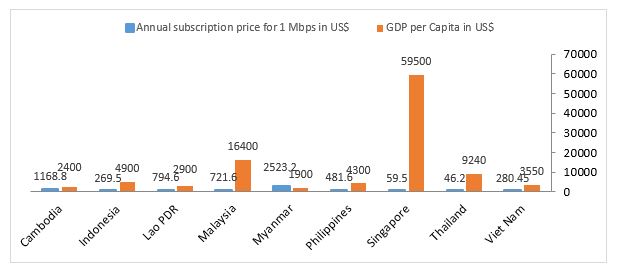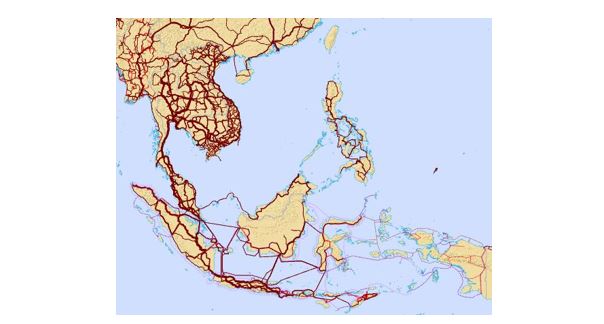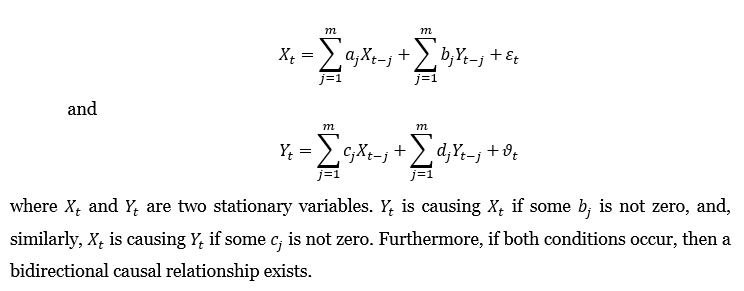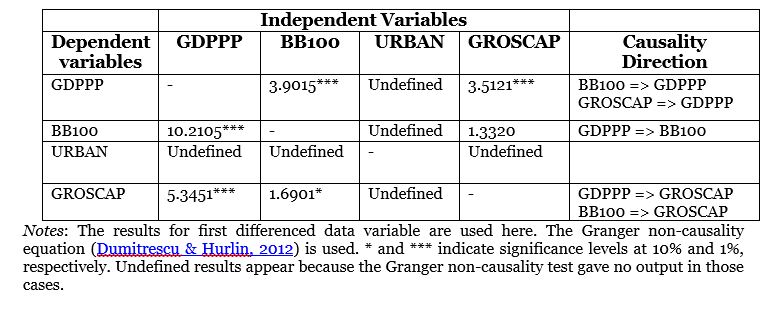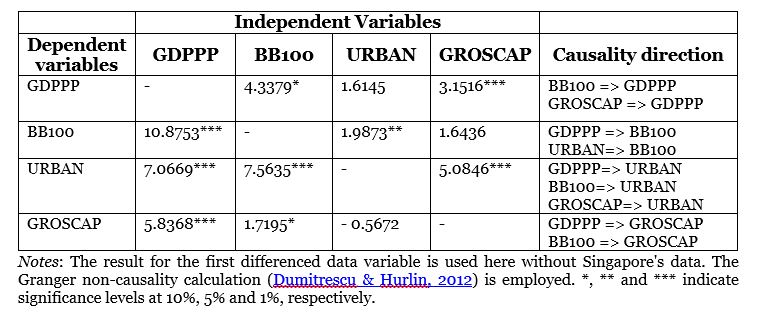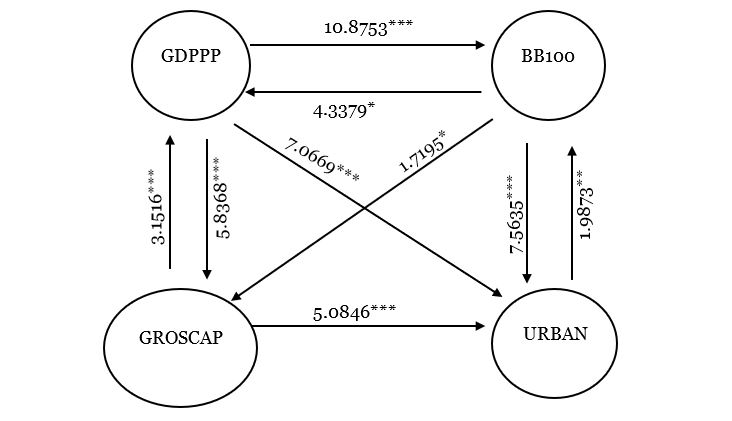Abstract
This study explores causal relationships between fixed broadband penetration, gross capital accumulation, the degree of urbanisation, and economic growth, using panel data from 9 ASEAN member countries in 2003-2016. Employing multivariate models, we reveal bidirectional causality between fixed broadband penetration and economic growth, with a higher magnitude of effect from GDP per capita to broadband penetration. Furthermore, fixed broadband penetration has bidirectional causality to urbanisation, while a unidirectional link exists from fixed broadband penetration to gross capital accumulation.
Introduction
Information and Communication Technology (ICT) has developed rapidly in recent decades and is viewed as an engine of development in the fourth industrial development phase. Telecommunication infrastructure as part of ICT has also evolved and offers better services such as broadband. In 2003, the International Telecommunication Union (ITU) standard defined broadband as access with a speed higher than ISDN, around 1.5 or 2.0 Megabits per second (Mbps). The always-on connection and higher rate of broadband offer more experiences and services, such as video streaming, online gaming, e-commerce and business solutions like cloud computing and the Internet of Things (IoT).
Broadband transforms people's lifestyle through online shopping, distance learning and teleworking. Broadband also facilitates less developed and emerging countries to expand and compete in the global economy. In a rural-urban context, broadband has brought equal opportunity in accessing information, learning and technology dissemination, thereby escalating economic capacity. In summary, broadband supports higher levels of development.
The important role of broadband in economic growth encourages abundant research at the global, regional, national, firm or household level. Despite the enthusiasm, limited studies exist for emerging economies such as those of most countries in the Association of Southeast Asian Nations (ASEAN). Furthermore, the impact of broadband on the economy needs further study because previous work mostly measures the impact of pre-broadband technology such as teledensity or dial-up. Moreover, most of the studies explore the correlation of broadband to economic growth, while causality between factors is not examined.
Another consideration is the integration spirit of ASEAN. The Southeast Asian region is collectively the third largest economy in Asia and the seventh largest in the world, with 622 million people and a US$2.6 trillion market. In 2015, the members established the ASEAN Economic Community (AEC), envisioning economic integration and shared prosperity. As an economic community, AEC also aimed to foster connectivity and cooperation. This vision makes studying ASEAN as a single economic entity plausible.
Therefore, this paper will explore causal relationships between fixed broadband penetration and economic growth in relation to growth of capital accumulation and urbanisation in ASEAN countries in the period 2003-2016. Employing a well-known Granger causality test, our multivariate research presents robust results, since ASEAN consists of countries with different levels of development. Furthermore, the long time span allows for implementing lags, based on the assumption that economic factors require time to have an effect on economic growth.
This paper is structured as follows. Section two gives a brief literature review of broadband and its economic effect, while section three describes broadband development in ASEAN. Section four describes the data and empirical model, and section five offers econometric analysis and empirical results. Section six includes discussion of the test results and a conclusion. Throughout this paper, we use the term "broadband" to mean fixed broadband.
Broadband and the Economy
ICT including broadband plays a substantial role in modern civilisation, especially in the last two decades. The advancement of telecommunication, specifically Internet access from narrowband to broadband, brings transformation, not only in terms of speed but also of varied applications and access quality (Cawley & Preston, 2007; Crandall, Lehr & Litan, 2007; Grubesic, 2004; Lau, Kim & Atkin, 2005). More sophisticated technology, such as multimedia, music and gaming, and later artificial intelligence, IoT and cloud services, have marked the vital role of broadband in every aspect of life.
Broadband access also has a positive impact on the economy, not only in terms of growth but also of income per capita (Bertschek et al., 2015; Van Gaasbeck, 2008). Moreover, broadband development has brought down the price to more affordable levels, increasing user numbers as well as broadband externality. The high impact of broadband on the economy positions it to help emerging economies compete with other countries, including developed ones.
Furthermore, broadband catalyses employment growth (Bouras, Diles & Kokkinos, 2013; Katz et al., 2010; Van Gaasbeck, 2008) and facilitates new business establishments (Kim & Orazem, 2017) such as creative industries and e-commerce. Moreover, broadband also impacts regional development (Bertschek et al., 2015), encourages innovation (Fanfalone, 2015; Ng, Lye & Lim, 2013; Rampersad & Troshani, 2013) and increases business productivity (Czernich et al., 2011; Falch, 2007; Van Gaasbeck, 2008).
In contrast, some studies suggest a weak impact from broadband on the manufacturing sector (Bertschek et al., 2015; Holt & Jamison, 2009; United Nations, 2015) compared to service industries such as tourism, finance and banking. Broadband is positioned as a general-purpose technology that benefits the service sectors more because it affects service mobility, which is challenging for manufacturing industries.
Furthermore, broadband helps human resources development (Kolko, 2012; LaRose et al., 2014). Broadband enables people to access knowledge and technology, giving the same opportunity to developed and emerging countries. Broadband also helps students, teachers and managers to access a broad range of services, content and applications (Tookey, Whalley & Howick, 2006). Moreover, broadband will decrease learning costs by using e-education, enabling knowledge dissemination despite distance, especially in rural areas (Falch & Henten, 2010). Better education will also increase people's capacity for work and finally support growth (Bertschek et al., 2015).
On the other hand, some studies (Bojnec et al., 2012; Grosso, 2006; Lemstra, Voogt & Van Gorp, 2015; OECD, 2002, 2008) found economic growth has affected broadband penetration. Broadband subscribers are increasing in line with rising income per capita as broadband becomes more affordable. In less developed nations, where income per capita is low as a result of low economic growth and productivity, broadband penetration is low. In these countries, broadband subscription services are expensive, since broadband infrastructure requires high investment in comparison to the low economic scale.
In summary, broadband plays a significant role in facilitating economic growth, increasing human resources capacity and closing the development gap between developing and developed countries.
ASEAN and Broadband Development
The formation of ASEAN in Bangkok, Thailand, on 8 August 1967, was marked by the Bangkok Declaration, known as the ASEAN Declaration (Asean.org, 2017). ASEAN was established as a community for economic cooperation and social and cultural development to build a prosperous and peaceful population in Southeast Asia, with mutual respect and equality between members. Furthermore, at the 9th ASEAN Summit in 2007, all members committed to the establishment of the ASEAN community by 2015 (Asean.org, 2017). The community has three pillars: ASEAN Political-Security Community; ASEAN Economic Community; and ASEAN Socio-Cultural Community. The three components are an implementation of ASEAN Vision 2020 to build and manage Southeast Asia as outward looking, living in peace, stability and prosperity, and promoting development through partnership between nations.
The ASEAN initiative for ICT development was marked by the signing of an e-ASEAN framework agreement at the ASEAN Informal Summit in Singapore in November 2000. The agreement focused on six primary actions: establishment of ASEAN information infrastructure; growth of electronic commerce; liberalisation of trade in ICT products and services and of investments; facilitation of trade in ICT products and services; capacity building and e-society; and e-government. Following the e-ASEAN agreement, in 2001, the first ASEAN Telecommunications Ministers Meeting (TELMIN) was held at Kuala Lumpur, Malaysia. At that event, ASEAN members realised the importance of ICT infrastructure and agreed to reduce the digital divide between member countries and develop an ASEAN information infrastructure. The e-ASEAN Integration Roadmap (2004-2010) became part of the ASEAN Framework Agreement for the Integration of Priority Sectors, and ICT was identified as one of 11 key sectors (International Development Research Centre, 2008).
After a series of meetings, ASEAN formulated the ASEAN ICT Masterplan 2015 (AIM2015) in 2011 at the 10th TELMIN in Kuala Lumpur. The AIM2015 aims to establish ICT as an engine of growth for ASEAN Member States; achieve recognition for ASEAN as a global ICT hub; enhance the quality of life for the people of ASEAN; and contribute towards ASEAN integration. The outcome will be achieved by implementing six pillars: economic transformation; people empowerment and engagement; innovation; infrastructure development; human capital development; and bridging the digital divide (Asean.org, 2011). To address the ICT sector dynamics, in November 2015, ASEAN members agreed to expand AIM2015 into the ASEAN ICT Masterplan 2020 (AIM2020), which added several points: ICT in the single market, new media and content and information security and assurance (Asean.org, 2016).
The ASEAN members agreed on infrastructure availability, especially broadband, to support ICT development. In the Bali Declaration 2008, members agreed to forge a partnership to develop high-speed connections to close the digital divide (Asean.org, 2008) and later to implement broadband across ASEAN (Asean.org, 2009).
Broadband development in the ASEAN region varies between countries because their development stages are also different. Different states of broadband are affected mostly by lack of affordable services and inaccessibility to broadband infrastructure (Ruddy & Ozdemir, 2013). For some countries, the unweighted average price of a 1 Mbps annual subscription reaches approximately 30% of GDP per capita, while the lowest price is 0.1% GDP per capita in Singapore, compared to 132.8% of GDP per capita in Myanmar (see Figure 1 for details).
Figure 1. Annual fixed broadband subscription price and GDP per capita in ASEAN member countries in 2012. Data retrieved from Ruddy & Ozdemir (2013).
Moreover, broadband coverage in the ASEAN region is concentrated in city centres since economic scale matters. Geographical obstacles also exist because some ASEAN member countries have extreme land conditions that hinder infrastructure deployment and diminish people's opportunities to access broadband services (see Figure 2). In addition to the backbone, limited last-mile coverage also hinders broadband development because reaching subscribers' premises is difficult. Some member countries tackle this challenge by employing DSL as a transitional technology (Ruddy & Ozdemir, 2013) to lower deployment cost amid a low number of fixed phone subscribers.
Figure 2. Fibre optic backbone map in Southeast Asia region. Reprinted from ITU interactive terrestrial transmission/ESCAP Asia-Pacific information superhighway maps by ITU, 19 November 2017, retrieved from http://www.itu.int/itu-d/tnd-map-public/ . © Copyright 2017 by ITU.
Data and Empirical Model
Data
This study utilized data of ASEAN member countries between 2003 and 2016 from the World Bank Development Index (WDI). ASEAN consists of 10 countries: Brunei Darussalam, Cambodia, Indonesia, Lao PDR, Malaysia, Myanmar, Philippines, Singapore, Thailand and Viet Nam. This research will omit Myanmar because some data are missing, and the estimation model requires balanced data.
Moreover, the data are treated as panel data since the Granger Causality test requires sufficient observations for each variable. Another consideration is the regional economic integration spirit of ASEAN as a single market, envisaged in the ASEAN Community Vision 2025.
This paper employs multivariate analysis using four variables: GDP per capita with purchasing power parity in international dollars as an economic growth measurement, symbolized by GDPPP; fixed broadband subscriptions per 100 population as a penetration ratio, expressed as BB100; gross capital accumulation percentage of GDP as a form of investment, symbolized by GROSCAP; and percentage of urban population to total population, expressed as URBAN. We employ a natural logarithm form of the variables in the calculation. Table 1 presents summary statistics of the variables in log form.
Table 1. Summary Statistics for the Variables
Panel Unit Root Test
The unit root test is a popular econometric method to analyse time series data. As research has advanced, the time series method has expanded to panel data computation with multiple observations and more prolonged periods, fuelling concern about spurious estimation from non-stationary data (Baltagi, 2013). In this study, we apply a three-panel unit root test: the Levine-Lin-Chu (LLC) test advised by Levin, Lin, and Chu (2002); the Augmented Dickey-Fuller (ADF)-Fisher chi-squared test recommended by Maddala and Wu (1999); and the Phillips Perron-Fisher chi-squared test proposed by Choi (2001). These three tests are recommended in many papers, presented in many econometric books, and included in current statistics software packages.
Panel Causality
A panel causality test was utilised to examine the causal relationship between two variables, because correlation is insufficient to test causality. Furthermore, a causality test can describe the causality direction, whether unidirectional, bidirectional or no causality. The causality calculation method was presented by Clive W. Granger (1969) in his paper titled âInvestigating Causal Relations by Econometric Models and Cross-spectral Methodsâ, known as the Granger causality test. Granger causality assumes the future cannot cause the past and, by employing a cross-sectoral model, a relationship between two or more variables in which one factor causes another can be validated (Granger, 1969). The simple causal model by Granger (1969) is:
Our research adopts a model from Arvin and Pradhan (2014) to calculate the causal relationship between variables for the 13 years from 2003-2016. As we are focusing on broadband's effect on economic growth in connection to capital and urbanisation, the model is modified as follows:
Hypotheses
From the model, we develop two main hypotheses to describe the possibility of a causal relationship between two variables:
GDPPP is GDP per capita based on purchasing power parity current international $, and BB100 is broadband subscriptions per 100 people.
Econometric Analysis and Empirical Results
Panel Unit Root Test
The Granger causality test requires data to be stationary to avoid spurious regression that is often affected by the existence of a trend in panel data. Table 2 presents the results of a three-unit root test for each variable.
Table 2. Results of Panel Unit Root Test
The unit root test results show that some variables are not stationary in level data. We repeat the computation using first differenced data and achieve the result that all data is stationary at 1% level of significance.
Granger Causality Test
Following the unit root test, we continued with the Granger causality test to detect causal relationships between variables using the models below. The Granger causality test will be employed on first differenced data using lags automatically chosen by the Akaike Information Criterion (AIC) to find optimum lags, as suggested by Akaike (1974).
where p, q, r and s are lag lengths for the differenced variables from the equation and can be determined with a Granger causality approach. See, for example, Arvin and Pradhan (2014). Tables 3 and 4 show the results of the panel data Granger causality tests.
Table 3. Panel Granger Causality Test Results
Six tests give undefined output for the URBAN variable, and after carefully checking the data, we found a problem in the urbanisation data for Singapore. Because it is a city-state, Singapore's population all live in the city, making the urban-to-population percentage 100% and thus producing zero value in the first differenced data for the URBAN variable. We omitted data for Singapore and repeated the Granger causality test, achieving the results in Table 4.
Table 4. Panel Granger Causality Test Results with Singapore Data Omitted
Based on the calculation of Formula 1, we find a strong Granger causality link variable with the procedure by Dumitrescu and Hurlin (2012). The causality direction is summarised in the right column of Table 4 and described further in the flow diagram in Figure 3. The result presents a wide range of causal relationships between the variables.
Figure 3. Granger Causality Directions Between Variables
Discussion
Although the result is clear, we intend to focus on the relationships between broadband and GDP growth. Viewing the hypothesis and Granger causality test result, we reject H01: BB100 does not Granger-cause GDPPP and H02: GDPPP does not Granger-cause BB100. We conclude there is a two-way causal link between broadband penetration and economic growth.
The results also suggest several issues in broadband penetration related to economic growth. First, the results show broadband penetration has a causal effect on GDP per capita growth, a view shared with previous studies (e.g. Bertschek et al., 2015; Van Gaasbeck, 2008) that place broadband as an accelerator for economic growth in line with capital and labour. The impact of broadband on economic growth can be in terms of productivity, efficiency and broader market access, as well as new business formulation and employment opportunities. Broadband also affects gross capital accumulation, as business and personal activities benefit from broadband utilisation in terms of increasing productivity and efficiency (Czernich et al., 2011; Falch, 2007; Van Gaasbeck, 2008), as well as decreasing capital requirements and promoting business expansion.
Second, we found the impact of GDP per capita growth on broadband penetration. The effect of GDP on broadband penetration has been presented in many studies (Bojnec et al., 2012; Grosso, 2006; Lemstra, Voogt & Van Gorp, 2015; OECD, 2002, 2008), viewing GDP per capita as the primary supporter for broadband penetration. Higher income per capita will increase purchasing power and make broadband services more affordable, leading to increasing subscriber numbers. Moreover, the result also shows urbanisation has Granger causality for broadband penetration. Urbanisation will facilitate broadband penetration (Lemstra et al., 2015; Wallsten, 2006) or demand (Koutroumpis, 2009), since urban people have higher education, employment status and technology experience, all of which support broadband adoption preferences (Hill, Troshani & Burgan, 2014).
While GDP per capita has a likely effect on broadband penetration, we found gross capital accumulation did not show a causal relationship with broadband penetration development. This can be understood when viewing the history of broadband development in the Southeast Asia region, where Digital Subscriber Line (DSL) became a central technology in the early stage of the broadband rollout (Ruddy & Ozdemir, 2013). DSL as a transitional technology required less capital compared to other technology, such as fibre-optic infrastructure, since DSL services use existing copper cable from plain old telephone service (POTS). In contrast to the operator benefit from utilising its traditional telephone network, the lower teledensity in ASEAN countries impacts broadband availability and limits penetration growth.
Furthermore, the increasing implementation of managed services in the telecommunication sector has decreased capital investment by telecommunication providers, as costs are reduced due to outsourcing efficiency and the transformation of capital expenditure (CAPEX) to operational expenditure (OPEX) (Esonwune, 2011). Managed services, as a consequence of increasing competition and falling telecommunication tariffs, have helped operators to deploy technology with less capital investment (as the assets are owned by the managed services vendor), along with limiting technological risk and the human resources required, as well as speeding deployment time.
Conclusion
Our results in some respects have shown the same view as existing literature, primarily on the impact of broadband penetration on economic growth. However, we also found a higher magnitude of effect from GDP on broadband penetration than from broadband penetration on GDP: this shows the importance of economic growth to promote broadband penetration in the ASEAN region, as affordability issues appear in some ASEAN member countries. Furthermore, broadband penetration benefited from urbanisation as well as economic growth, despite no causality from gross capital accumulation to broadband penetration.
We also affirm that variable and sample selection has a substantial effect on the results, when employing multivariate and panel causality tests.
Acknowledgements
The author gratefully appreciates the financial support from the Indonesian Endowment Fund for Education (LPDP), which gave him the opportunity to conduct this research. He also thanks Professor Hitoshi Mitomo and he acknowledges the useful discussion and helpful comments of his PhD colleagues.
References
Akaike, H. 1974. 'A new look at the statistical model identification'. IEEE Transactions on Automatic Control, 19(6), 716â723. https://doi.org/10.1109/TAC.1974.1100705
Arvin, BMM; Pradhan, RP. 2014. 'Broadband penetration and economic growth nexus: evidence from cross-country panel data'. Applied Economics, 46(35), 4360â4369. https://doi.org/10.1080/00036846.2014.957444
Asean.org. 2008. Bali Declaration in Forging Partnership to Advance High Speed Connection to Bridge Digital Divide in ASEAN Bali, Indonesia, 29 August 2008. Retrieved 14 November 2017 from http://asean.org/?static_post=bali-declaration-in-forging-partnership-to...
Asean.org. 2009. Vientiane Declaration on Promoting the Realisation of Broadband Across ASEAN Vientiane, 15 October 2009. Retrieved 14 November 2017 from http://www.asean.orgâ/wp-content/uploads/images/archive/TELMIN/Vientiane-Declaration-TELMIN-9.pdf
Asean.org. 2011. ASEAN ICT Masterplan 2015. Jakarta: ASEAN Secretariat. Retrieved from http://www.scribd.com/doc/111870071/ASEAN-ICT-Masterplan-2015
Asean.org. 2016. ASEAN ICT Masterplan 2020. Jakarta: ASEAN Secretariat. Retrieved from http://www.asean.org/storage/images/2015/November/ICT/15b -- AIM 2020_âPublication_âFinal.pdf
Asean.org. 2017. Overview - ASEAN. Retrieved 14 November 2017 from http://asean.orgâ/aseanâ/about-asean/overview/
Baltagi, B. 2013. Econometric Analysis of Panel Data. Fifth Edition. John Wiley & Sons. Retrieved from https://books.google.co.jp/books?id=oQdx_70Xmy0C
Bertschek, I; Briglauer, W; Hüschelrath, K; Kauf, B; Niebel, T. 2015. 'The Economic Impacts of Broadband Internet: A survey'. Review of Network Economics, 14(4), 201-227. https://doi.org/10.1515/rne-2016-0032
Bojnec, S; FertÅ, I. 2012. 'Broadband availability and economic growth'. Industrial Management & Data Systems, 112(9), 1292â1306. https://doi.org/10.1108/0263557121127â8938
Bouras, C; Diles, G; Kokkinos, V. 2013. 'Impact of broadband public infrastructures and services on SEE countriesâ economy'. 4th Global Information Infrastructure and Networking Symposium (GIIS 2013), Trento, Italy. https://doi:10.1109/GIIS.2013.6684353
Cawley, A; Preston, P. 2007. 'Broadband and digital âcontentâ in the EU-25: Recent trends and challenges'. Telematics and Informatics, 24(4), 259â271. https://doi.org/10.1016â/j.tele.2007.01.015
Choi, I. 2001. 'Unit root tests for panel data'. Journal of International Money and Finance, 20(2), 249â272. https://doi.org/10.1016/S0261-5606(00)00048-6
Crandall, R; Lehr, W; Litan, R. 2007. 'The Effects of Broadband Deployment on Output and Employment: A Cross-sectional Analysis of U.S. Data'. Issues in Economic Policy, 6, July 2007, 1â34.
Czernich, N; Falck, O; Kretschmer, T; Woessmann, L. 2011. 'Broadband Infrastructure and Economic Growth'. The Economic Journal, 121, 505â532. https://doi.org/10.1111/j.1468-0297.2011.02420.x.
Dumitrescu, E.-I; Hurlin, C. 2012. 'Testing for Granger non-causality in heterogeneous panels'. Economic Modelling, 29(4), 1450â1460. https://doi.org/10.1016â/j.econmodâ.2012.02.014
Esonwune, C. 2011. Telecommunications Managed Services Model in sub-Saharan Africa â The Pros and Consâ¯: The Case of Nigeria. Blekinge Institue of Technology. Retrieved from http://urn.kb.se/resolve?urn=urn:nbn:se:bth-5578%0A
Falch, M. 2007. 'Penetration of broadband services â The role of policies'. Telematics and Informatics, 24(4), 246â258. https://doi.org/10.1016/j.tele.2007.01.008
Falch, M; Henten, A. 2010. 'Public private partnerships as a tool for stimulating investments in broadband'. Telecommunications Policy, 34(9), 496â504. https://doi.org/10.1016â/j.telpol.2010.07.010
Fanfalone, AG. 2015. Post-2015 Development Agenda- Mexico Perspectives: ICT Infrastructure. Retrieved from https://www.copenhagenconsensus.comâ/sites/defaultâ/files/mexico_ict_resouces.pdf
Granger, CWJ. 1969. 'Investigating Causal Relations by Econometric Models and Cross-spectral Methods'. Econometrica, 37(3), 424-438. https://doi.org/10.2307/1912791
Grosso, M. 2006. 'Determinants of Broadband Penetration in OECD Nations'. Communications, 1â31.
Grubesic, TH. 2004. 'The geodemographic correlates of broadband access and availability in the United States'. Telematics and Informatics, 21(4), 335â358. https://doi.org/10.1016â/j.tele.2004.02.003
Hill, SR; Troshani, I; Burgan, B. 2014. 'Broadband adoption in regional and urban households'. Journal of Computer Information Systems, 54(3), 57-66.
Holt, L; Jamison, M. 2009. 'Broadband and contributions to economic growth: Lessons from the US experience'. Telecommunications Policy, 33(10â11), 575â581. https://doi.org/10.1016â/j.telpol.2009.08.008
International Development Research Centre. 2008. Digital Review of Asia Pacific 2007/2008. Singapore: SAGE Publications. Retrieved from https://idl-bnc-idrc.dspacedirect.org/bitstream/handle/10625/34958/IDL-3...
Katz, RL; Vaterlaus, S; Zenhäusern, P; Suter, S. 2010. 'The impact of broadband on jobs and the German economy'. Intereconomics, 45(1). https://doi.org/10.1007/s10272-010-0322-y
Kim, Y; Orazem, PFPF. 2017. 'Broadband Internet and new firm location decisions in rural areas'. American Journal of Agricultural Economics, 99(1), 285â302. https://doi.orgâ/10.1093/ajae/aaw082
Kolko, J. 2012. 'Broadband and local growth'. Journal of Urban Economics, 71(1), 100â113. https://doi.org/10.1016/j.jue.2011.07.004
Koutroumpis, P. 2009. 'The economic impact of broadband on growth: A simultaneous approach'. Telecommunications Policy, 33(9), 471â485. https://doi.org/10.1016â/j.telpol.2009.07.004
LaRose, R; Bauer, JM; DeMaagd, K; Chew, HE; Ma, W; Jung, Y. 2014. 'Public broadband investment priorities in the United States: an analysis of the broadband technology opportunities program'. Government Information Quarterly, 31(1), 53â64. https://doi.orgâ/10.1016/j.giq.2012.11.004
Lau, TY; Kim, SW; Atkin, D. 2005. 'An examination of factors contributing to South Koreaâs global leadership in broadband adoption'. Telematics and Informatics, 22(4), 349â359. https://doi.org/10.1016/j.tele.2004.11.004
Lemstra, W; Voogt, B; Van Gorp, N. 2015. 'Measuring broadband in Europe: Development of a market model and performance index using structural equations modelling'. Telecommunications Policy, 39(3â4), 253â268. https://doi.org/10.1016/j.telpol.2015.01.â006
Levin, A; Lin, C-F; Chu, C-SJ. 2002. 'Unit root tests in panel data: asymptotic and finite-sample properties'. Journal of Econometrics, 108(1), 1â24. https://doi.org/10.1016/S0304-4076(01)00098-7
Maddala, GS; Wu, S. 1999. 'A Comparative Study of Unit Root Tests with Panel Data and a New Simple Test'. Oxford Bulletin of Economics and Statistics, 61(s1), 631â652. https://doi.org/10.1111/1468-0084.61.s1.13
Ng, TH; Lye, CT; Lim, Y. S. 2013. 'Broadband penetration and economic growth in ASEAN countries: a generalized method of moments approach'. Applied Economics Letters, 20(9), 857â862. https://doi.org/10.1080/13504851.2012.754538
OECD. 2002. The Development of Broadband Access in OECD Countries. OECD Publishing. https://doi.org/10.1787/9789264034754-en
OECD. 2008. Broadband Growth and Policies in OECD Countries. OECD Publishing. https://doi.org/10.1787/9789264046764-en
Rampersad, G; Troshani, I. 2013. 'Innovation in the digital economy: The impact of high-speed broadband on innovating SMEs'. In Proceedings of the 24th Australasian Conference on Information Systems, 4-6December 2013, Melbourne.
Ruddy, M; Ozdemir, E. 2013. An In-Depth Study of Broadband Infrastructure in the ASEAN Region. Bangkok: UN ESCAP.
Tookey, A; Whalley, J; Howick, S. 2006. 'Broadband diffusion in remote and rural Scotland'. Telecommunications Policy, 30(8â9), 481â495. https://doi.org/10.1016/j.telpol.2006.â06.001
United Nations. 2015. 'Information Economy Report 2015: Unlocking the Potential of E-commerce for Developing Countries'. In United Nations Conference on Trade and Development, 19, 1â28. Geneva. https://doi.org/10.1093/ijlit/eaq011
Van Gaasbeck, KA. 2008. 'A rising tide: Measuring the economic effects of broadband use across California'. The Social Science Journal, 45(4), 691â699. https://doi.org/10.1016â/j.soscij.2008.09.017
Wallsten, S. 2006. 'Broadband and Unbundling Regulations in OECD Countries'. SSRN Electronic Journal. https://doi.org/10.2139/ssrn.906865

